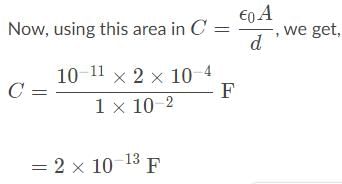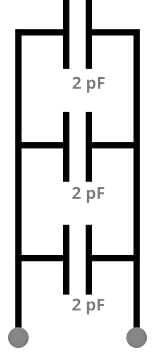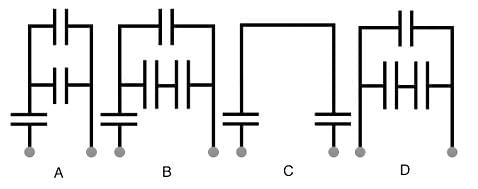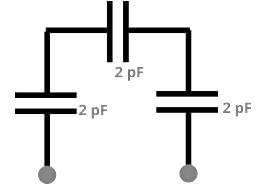All Exams >
MCAT >
Physics for MCAT >
All Questions
All questions of Capacitors for MCAT Exam
In a parallel-plate capacitor, how can the capacitance be decreased?- a)Increasing the stored charge in the capacitor
- b)Decreasing the stored charge in the capacitor
- c)Decreasing the gap between the charged plates
- d)Increasing the gap between the charged plates
Correct answer is option 'D'. Can you explain this answer?
In a parallel-plate capacitor, how can the capacitance be decreased?
a)
Increasing the stored charge in the capacitor
b)
Decreasing the stored charge in the capacitor
c)
Decreasing the gap between the charged plates
d)
Increasing the gap between the charged plates
|
|
Ayesha Joshi answered |
- Recall the capacitance formula for a parallel plate capacitor.
- The formula is C = ε0A/d, with A being the surface area of one of the plates and d being the distance between two plates. Note that capacitance can be inferred purely from geometric properties of the capacitor.
- Increasing the gap between in charged plates will decrease the capacitance.
Imagine a parallel-plate capacitor with a plate separation of d = 1 cm. The plates are both right triangles with both base and height equal to 2 cm. What is the capacitance of this capacitor? (assume 
- a)2 × 10−13F
- b)5 × 10−9F
- c)2 × 10−15 F
- d)5 × 10−7F
Correct answer is option 'A'. Can you explain this answer?
Imagine a parallel-plate capacitor with a plate separation of d = 1 cm. The plates are both right triangles with both base and height equal to 2 cm. What is the capacitance of this capacitor? (assume 

a)
2 × 10−13F
b)
5 × 10−9F
c)
2 × 10−15 F
d)
5 × 10−7F
|
|
Ayesha Joshi answered |
- Recall the capacitance formula for a parallel plate capacitor:

- We need to find surface area A of each plate,




- The capacitance of this capacitor is 2 × 10−13F
Four capacitors of 10 pF are connected in parallel with two of the capacitors having a Mylar dielectric (κ = 3) of thickness L inserted and two capacitors only separated by air at a distance L. A voltage potential of 40 V is applied across the circuit and subsequently disconnected. The Mylar dielectrics are then removed and charges are allowed to equilibrate in the system. What is the energy stored on each capacitor?- a)32000 pJ
- b)64000 pJ
- c)6400 pJ
- d)3200 pJ
Correct answer is option 'A'. Can you explain this answer?
Four capacitors of 10 pF are connected in parallel with two of the capacitors having a Mylar dielectric (κ = 3) of thickness L inserted and two capacitors only separated by air at a distance L. A voltage potential of 40 V is applied across the circuit and subsequently disconnected. The Mylar dielectrics are then removed and charges are allowed to equilibrate in the system. What is the energy stored on each capacitor?
a)
32000 pJ
b)
64000 pJ
c)
6400 pJ
d)
3200 pJ
|
|
Ellie Gonzales answered |
Εr = 3.1) and the other two having a ceramic dielectric (εr = 8.5).
To find the equivalent capacitance of the parallel combination of capacitors, we can simply add up the individual capacitances.
For the capacitors with Mylar dielectric, the capacitance is given by:
C1 = C2 = 10 pF
For the capacitors with ceramic dielectric, the capacitance is given by:
C3 = C4 = 10 pF
Now, we can calculate the total capacitance:
Ctotal = C1 + C2 + C3 + C4
= 10 pF + 10 pF + 10 pF + 10 pF
= 40 pF
Therefore, the equivalent capacitance of the parallel combination of these four capacitors is 40 pF.
To find the equivalent capacitance of the parallel combination of capacitors, we can simply add up the individual capacitances.
For the capacitors with Mylar dielectric, the capacitance is given by:
C1 = C2 = 10 pF
For the capacitors with ceramic dielectric, the capacitance is given by:
C3 = C4 = 10 pF
Now, we can calculate the total capacitance:
Ctotal = C1 + C2 + C3 + C4
= 10 pF + 10 pF + 10 pF + 10 pF
= 40 pF
Therefore, the equivalent capacitance of the parallel combination of these four capacitors is 40 pF.
Four capacitors of 10 pF are connected in parallel with two of the capacitors having a Mylar dielectric (κ = 3) of thickness L inserted and two capacitors only separated by air at a distance L. A voltage potential of 40 V is applied across the circuit. How does the charge stored on the capacitors differ between the capacitors with the Mylar and without?- a)The Mylar capacitors store 1/30 times as much charge as the air capacitors.
- b)The Mylar capacitors store 3 times as much charge as the air capacitors.
- c)The Mylar capacitors store 30 times as much charge as the air capacitors.
- d)The Mylar capacitors store 1/3 times as much charge as the air capacitors.
Correct answer is option 'B'. Can you explain this answer?
Four capacitors of 10 pF are connected in parallel with two of the capacitors having a Mylar dielectric (κ = 3) of thickness L inserted and two capacitors only separated by air at a distance L. A voltage potential of 40 V is applied across the circuit. How does the charge stored on the capacitors differ between the capacitors with the Mylar and without?
a)
The Mylar capacitors store 1/30 times as much charge as the air capacitors.
b)
The Mylar capacitors store 3 times as much charge as the air capacitors.
c)
The Mylar capacitors store 30 times as much charge as the air capacitors.
d)
The Mylar capacitors store 1/3 times as much charge as the air capacitors.
|
|
Ayesha Joshi answered |
- Dielectrics help increase the capacitance of the capacitor, allowing additional charge to be stored on the capacitor.
- Capacitance increases by the dielectric constant as: Cnew = C*K. Given C = ε0A/d and Q = CV, we can have the modified Q = Kε0 AV/d for a capacitor with a dielectric.
- The Mylar capacitors store 3 times as much charge as the air capacitors.
What is the equivalent capacitance of this circuit?

- a)2/3 pF
- b)6 pF
- c)1/6 pF
- d)3/2 pF
Correct answer is option 'B'. Can you explain this answer?
What is the equivalent capacitance of this circuit?


a)
2/3 pF
b)
6 pF
c)
1/6 pF
d)
3/2 pF
|
|
Ayesha Joshi answered |
- Recall equivalent capacitance in a circuit where the elements are connected in parallel.
- Cequivalent = C1 + C2 + C3.
- The equivalent capacitance is 6 pF.
A parallel plate capacitor separated 10 cm, by an air barrier is connected to a 100 V battery. The capacitance of the capacitor is 1 picofarad while the battery is connected. Without disconnecting the battery, the parallel plates are moved so they are now 20 cm apart. What happens to the energy stored in the capacitor?- a)It increases fourfold
- b)It increases by half
- c)It decreases fourfold
- d)It decreases by half
Correct answer is option 'D'. Can you explain this answer?
A parallel plate capacitor separated 10 cm, by an air barrier is connected to a 100 V battery. The capacitance of the capacitor is 1 picofarad while the battery is connected. Without disconnecting the battery, the parallel plates are moved so they are now 20 cm apart. What happens to the energy stored in the capacitor?
a)
It increases fourfold
b)
It increases by half
c)
It decreases fourfold
d)
It decreases by half
|
|
Ayesha Joshi answered |
- Since this question does not ask for actual numeric answers, it's easier to determine relationships rather than "plugging-and-chugging" for the actual answer. Recall the formula for energy stored in a capacitor: U = 0.5QV. Try to express this in terms of C.
- Given Q = CV, U = 0.5 CV2. You know that
 so substitute that in.
so substitute that in. - Since the potential difference is maintained, you should see that
 d increases from 10 cm to 20 cm.
d increases from 10 cm to 20 cm. - The energy stored in the capacitor decreases by half when the plates are moved from 10 cm to 20 cm apart.
What is the correct order of the capacitances of these circuits, from lowest to highest? Assume all capacitors have the same capacitance.
- a)B < A < C < D
- b)D < C < B < A
- c)C < B < A < D
- d)D < C < A < B
Correct answer is option 'C'. Can you explain this answer?
What is the correct order of the capacitances of these circuits, from lowest to highest? Assume all capacitors have the same capacitance.

a)
B < A < C < D
b)
D < C < B < A
c)
C < B < A < D
d)
D < C < A < B
|
|
Ayesha Joshi answered |
- For convenience, we’ll say that the capacitance of each capacitor is 1 F; the answer is independent of what value we pick.
- We instantly can infer the capacitance of choice “C” using the series addition formula, 1/Ctotal = 1 + 1 and so Ctotal = 1/2.
- For circuit “D,” we first use the series formula for the bottom rung, 1/Cbottom = 1/1 + 1/1 F, to find that Cbottom = 1/2 F. We then use the parallel formula to add this rung to the capacitance of the top rung for a total capacitance of Ctotal = 1/2 + 1 = 3/2 F
- We can determine the capacitance of circuit “A” by first combining the two capacitors in parallel Ctotal = 1 + 1 = 2 F. We then add this in series with the capacitor on the left to find 1/Ctotal = 1/2 + 1 F, and so Ctotal = 2/3 F
- We recognize that circuit “B” is the same as circuit “D”, except we have to add another capacitor in series with the entirety of choice D. 1/Ctotal = 2/3 + 1 and so Ctotal = 3/5 F
- Combining our results, we find C < B < A < D
Which of the following parallel plate capacitors will store the most charge on the positive plate when a potential difference V is applied across the plate?- a)Plates separated by vacuum of distance L/2
- b)Plates separated by vacuum of distance L
- c)Plates separated by glass of thickness L
- d)Plates separated by glass of thickness L/2
Correct answer is option 'D'. Can you explain this answer?
Which of the following parallel plate capacitors will store the most charge on the positive plate when a potential difference V is applied across the plate?
a)
Plates separated by vacuum of distance L/2
b)
Plates separated by vacuum of distance L
c)
Plates separated by glass of thickness L
d)
Plates separated by glass of thickness L/2
|
|
Ayesha Joshi answered |
- A dielectric is a material that is placed between parallel plate capacitors to increase the capacitance of the capacitor. Glass and vacuum are examples of dielectric material.
- Capacitance increases by the dielectric constant as: Cnew = C*K. Vacuum is the most basic dielectric at κ = 1. Almost everything you encounter on the test that is not air or vacuum will have a higher dielectric constant (glass is 5). Given C = ε0A/d and Q = CV, we can have the modified Q = Kε0AV/d for a capacitor with a dielectric.
- The parallel plate capacitor with plates separated by glass of thickness L/2 will store the most charge.
If you are given a large parallel-plate capacitor containing just air as a dielectric, which of the following tools would be sufficient to determine the capacitor’s capacitance?- a)An ohmmeter
- b)A voltmeter and an ammeter
- c)A ruler and an ohmmeter
- d)A ruler
Correct answer is option 'D'. Can you explain this answer?
If you are given a large parallel-plate capacitor containing just air as a dielectric, which of the following tools would be sufficient to determine the capacitor’s capacitance?
a)
An ohmmeter
b)
A voltmeter and an ammeter
c)
A ruler and an ohmmeter
d)
A ruler
|
|
Ayesha Joshi answered |
- Think about which formulas you know for capacitors: the fact that the question specifies parallel-plate means that you can use the formula C = ε0 A/d in addition to Q = CV.
- It is impossible to infer the capacitance purely from the voltage or resistance of a circuit with a capacitor; you must also know the charge on the capacitor.
- The plate area and separation are both purely geometric properties, and so a ruler is all you need to determine the capacitance.
What is the equivalent capacitance of this circuit?
- a)1/6 pF
- b)2/3 pF
- c)6 pF
- d)3/2 pF
Correct answer is option 'B'. Can you explain this answer?
What is the equivalent capacitance of this circuit?

a)
1/6 pF
b)
2/3 pF
c)
6 pF
d)
3/2 pF
|
|
Ayesha Joshi answered |
- Recall equivalent capacitance in a circuit where the elements are connected in series.


- To find Cequivalent, you must take the reciprocal of both sides. The equivalent capacitance is 2/3 pF.
Chapter doubts & questions for Capacitors - Physics for MCAT 2025 is part of MCAT exam preparation. The chapters have been prepared according to the MCAT exam syllabus. The Chapter doubts & questions, notes, tests & MCQs are made for MCAT 2025 Exam. Find important definitions, questions, notes, meanings, examples, exercises, MCQs and online tests here.
Chapter doubts & questions of Capacitors - Physics for MCAT in English & Hindi are available as part of MCAT exam.
Download more important topics, notes, lectures and mock test series for MCAT Exam by signing up for free.
Physics for MCAT
158 videos|21 docs|21 tests
|

Contact Support
Our team is online on weekdays between 10 AM - 7 PM
Typical reply within 3 hours
|
Free Exam Preparation
at your Fingertips!
Access Free Study Material - Test Series, Structured Courses, Free Videos & Study Notes and Prepare for Your Exam With Ease

 Join the 10M+ students on EduRev
Join the 10M+ students on EduRev
|

|
Create your account for free
OR
Forgot Password
OR
Signup on EduRev and stay on top of your study goals
10M+ students crushing their study goals daily









